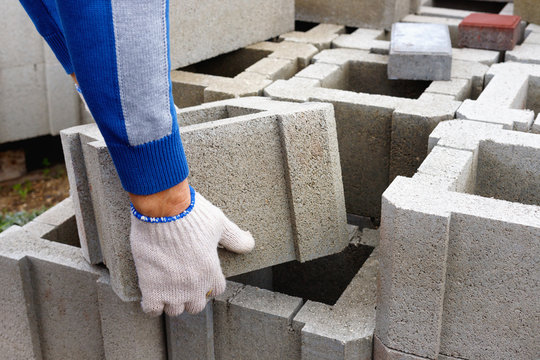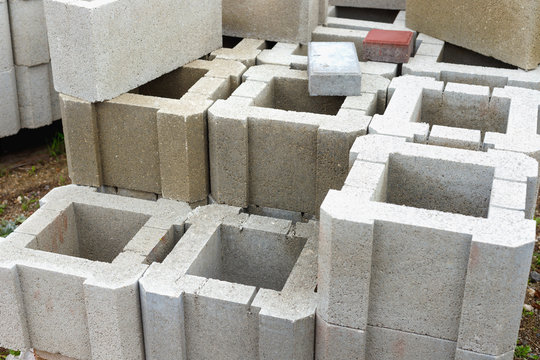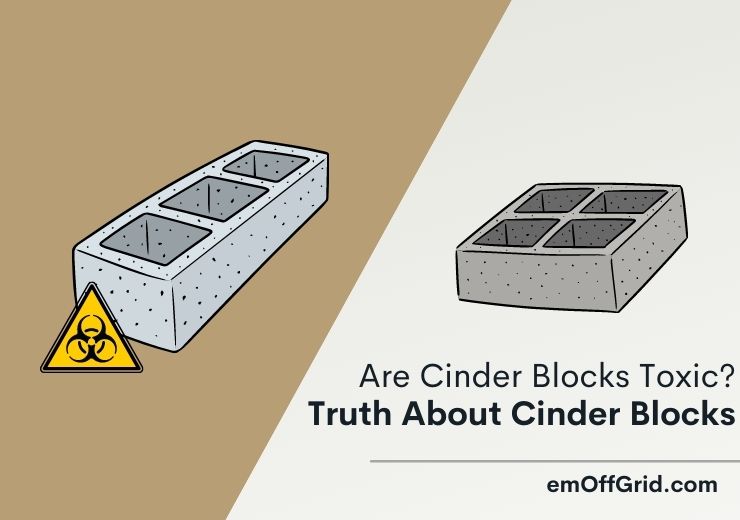Many people prefer cinder blocks for construction because they are cost-effective, light, and strong.
However, do you know that they are unsafe for raised garden beds? Cinder blocks are toxic, and we believe you should know the truth.
Cinder blocks made with fly ash can release harmful chemicals and heavy metals into the soil. Planting fruits and vegetables on that soil can poison whoever consumes them.
Stay focused as we unmask the toxicity of cinder blocks in this article. We will also state a few ways of minimizing its effects on the soil. Read on to get all the details.
Contents
Are Cinder Blocks Toxic?

Yes. Cinder blocks are made of harmful ingredients that can leach into the soil. If your garden beds are constructed with cinder blocks, these harmful components can leach into the ground.
Goring fruits and vegetables in a garden whose beds are constructed with cinder blocks can lead to poisoning. Such plants can harm people and animals that eat them.
Cinder blocks are made of fly ash, a byproduct of burning coal. Aluminum oxide, calcium oxide, and magnesium oxide from fly ash can get into the soil. It can also leach heavy metals such as lead and arsenic.
What Are Cinder Blocks?
Cinder blocks are hollow rectangular blocks made with fly ash and Portland cement. Fly ash component of cinder blocks makes them lighter than concrete blocks, but they still maintain their strength.
They are also considered a greener option because they are made with fly ash, a byproduct of burning coal.
Distinguish Cinder Blocks And Concrete
Concrete blocks or cement blocks are made with Portland cement and aggregates. There is no fly ash in them.
As a result, they are heavier and more expensive than cinder blocks. Cement blocks are also non-toxic and can be safely used in making raised beds.
Concrete blocks are not generally considered toxic. They have been used for centuries in building constructions without reported health effects.
But due to their high prices, a cost-effective alternative was introduced.
Cinder blocks are equally strong, but those made of fly ash pose health problems when used in garden bed constructions.
How Harmful Are Cinder Blocks?
Not all cinder blocks are harmful; only ones made of fly ash are toxic.
But how do you know if the cinder blocks you are buying don’t have this substance? Since people can’t tell the difference, we generally refer to all cinder blocks as harmful.
Cinder Blocks Contain Fly Ash Can Leach Toxic Heavy Metal
Cinder blocks are toxic, but what is in them that makes them unsuitable for raised garden beds? They contain fly ash. So, let us get into the details of this harmful substance.
What is Fly Ash

We have hinted that fly ash is a byproduct of burning coal. It is produced in large quantities in coal-burning power plants.
Before enforcing pollution regulations, fly ash would be blasted into the atmosphere. But currently, they are recycled and used in cinder block manufacturing.
Coal contains heavy metals and many other substances known to cause health problems. Some toxic constituents remain in the ash when energy from the coal has been extracted by the boilers.
They are then passed on to the cinder blocks. When used in constructing raised beds, the toxic chemicals leach into the soil.
Why is Fly Ash Used in Making Cinder Blocks?
Fly ash is used in making cinder blocks because it is cheap and readily available, leading to cost-effective and light blocks for construction.
Recycling fly ash makes cinder blocks eco-friendly building materials. Cinder blocks come with all these advantages while still maintaining the strength of concrete blocks.
Types Of Fly Ash
Fly ash is grouped into two classes: class F and class C. The class F fly ash is anthracite or bituminous coal burned in boilers.
Coal that produces class F fly ash is harder and older than ignite or sub-bituminous coal.
Class F fly ash is considered pozzolanic, a name coined from where the coal comes from.
Pozzolan is a kind of volcanic ash that originates from Pozzuoli in Italy. It has more alumino-silicate glass and quartz, which make it less valuable.
Class C fly is richer in lime, alkali, and sulfate and considered more cementitious and hydraulic.
Its main chemical constituents include calcium-rich glass, calcium sulfate, and magnesium oxide. Class C fly ash is ideal for making cinder blocks because of these properties.
How To Tell If You Have Cinder Blocks Containing Fly Ash?
It is easy to tell if your cinder blocks are made of fly ash or not.
Apart from asking your manufacturer about the ingredients, you can simply compare the weight and cost. Fly ash cinder blocks are cheaper and lighter.
When buying cinder blocks for constructing your garden beds, get them from a reputable company that will openly tell you the ingredients.
Also, consider new cinder blocks. That is opposed to the old ones because you have no reliable way of knowing the constituents.
Always be cautious about what you use, especially when you want to plant fruits and vegetables in your garden.
Lime Seeps Into The Soil, Changing PH
Lime used in making cinder blocks can leach into the soil, which raises its pH value.
Fortunately, the soil pH can be monitored by regularly testing soil samples. You can then apply an appropriate remedy to restore the pH value to a level that supports plant growth.
However, it still remains to be costly in the long run. Soil testing and correction measures all take your time and money, which you could have diverted to developing other sectors.
5 Ways To Minimize Effects Of Cinder Blocks

Even though cinder blocks are toxic, you can still use them for raising garden beds by minimizing their effects.
If you can block the harmful chemicals in the cinder blocks from leaching into the soil, they become reliable construction materials. Alternatively, you can buy fly ash-free cinder blocks.
So, how do you stay safe when using cinder blocks? Consider the following methods:
Buy Cinder Blocks New From The Prestigious Concrete Plant

The benefit of buying cinder blocks from a reputable company is high integrity. You can trust what they tell you as the ingredients for their cinder blocks if you ask them.
Not all cinder blocks are toxic. Some are made without fly ash and are safe for use in gardens, but you should be sure that is the case.
That is also the reason for recommending new cinder blocks over old ones. It is easier to tell what is in the mix if you buy the blocks from a prestigious company.
Lining Cinder Blocks With Plastic Or Some Other Protective Layer
If you are unsure about the toxicity of your cinder blocks, use the barrier method to ensure your garden is safe.
This method involves using physical barriers to block harmful chemicals in cinder blocks from leaching into the soil.
Use a waterproof sealant or liner such as plastic to cover the cinder block wall. Without water getting into the cinder blocks, the chemicals have no way of getting into the soil.
You can then plant your fruits and vegetables without worrying about the toxicity of cinder blocks.
ACTREY 22Mil 13 x 20 Feet PVC
- 𝗣𝗥𝗢𝗧𝗘𝗖𝗧 𝗬𝗢𝗨𝗥 𝗣𝗢𝗡𝗗: This liner will help to contain your pond, while also creating a safe and healthy environment for wildlife and plants. Help take care of your water features, pond pumps, filters, and more with the liner in place
- 𝗦𝗔𝗙𝗘 𝗠𝗔𝗧𝗘𝗥𝗜𝗔𝗟: Made of good quality HDPE, our liner is UV and puncture resistant, can be used for many years; Environmentally friendly, safe for your fish and plant
- 𝗣𝗟𝗜𝗔𝗕𝗟𝗘 𝗔𝗡𝗗 𝗙𝗟𝗘𝗫𝗜𝗕𝗟𝗘: Conforms to a variety of irregular surfaces. Excellent choice for water gardens, fish ponds and backyard waterfalls. This light weight liner is easy to install
Don’t Plant Edibles Inside The Hollow Chambers
One resilient feature of cinder blocks is the hollow chamber at the center of the cinder block.
Many homesteaders use them as planting containers, but this should never be the case. Doing that makes it easy for the plants to absorb toxins in the cinder block.
Don’t imagine planting fruits or vegetables in the hollow chambers of cinder blocks. In fact, avoid planting anything edible close to them.
If you must use them in your garden, leave a considerable distance between the walls and the plants. Don’t make it easy for the plants to absorb the poison.
Check out:
- 26 Delicious Edible Plants To Grow Indoors
- 7 Useful And Beautiful Homestead Plants To Grow
Plant Flowers/ Cleansing Plants Instead Of Fruit Trees
Sometimes you are just unsure about the toxicity of your soil. If you suspect that it is contaminated, try phytoremediation.
That is the use of specific plant species to reclaim land contaminated with chemicals. Plant them in your garden for a few seasons to clean and neutralize the toxins.
Safely dispose of the plant matter after every season. Using the same plant matter as compost can reintroduce the toxins into the soil. Consider the following plant species for phytoremediation:
- Indian mustard (Brassica juncea L.)
- Willow (Salix species)
- Poplar tree (Populus deltoides)
- Indian grass (Sorghastrum nutans)
- Sunflower (Helianthus Annuus L.)
Make Your Own Concrete Blocks
What more can you do to ensure the safety of the blocks you use for raising your garden beds? DIY concrete block making is the best alternative if you have the materials and tools.
Consider a natural Roman Concrete made by crushing and baking limestone or seashells and then mixing with sand and aggregates.
As you can see, the constituents of this block are all-natural. If you are lucky, you can source everything from your land. That gives no chance for chemicals and heavy metals.
Once you have the appropriate natural concrete block mixture, transfer it into the molds and allow time to dry.
Making your own concrete blocks also comes with additional benefits. You can vary the shape and size to suit your needs.
Also, you can consider removing the cement mixture at the center since you don’t need it just for garden beds.
FAQs
What are cinder blocks made of?
Cinder blocks are made of concrete and fly ash, which is the byproduct of burning coal.
Due to the hollowness and fly ash, cinder blocks are lighter and cost-effective. They are also as strong as cement blocks, making them reliable construction materials.
Why do cinder blocks have holes?
The openings in cinder blocks are called cells. They are design features that make cinder blocks lighter, cost-effective, and easy to handle.
The holes also make them easily align from top to bottom to make a tall vertical wall.
Should you fill cinder blocks with concrete?
Whether to fill cinder blocks or not depends on the purpose. If you are building a foundation, cinder blocks are reinforced with rebar and filled with concrete to strengthen them.
If you are just constructing a wall or raising garden beds, filling the holes is unnecessary. Cinder blocks are strong enough to support the weight.
Ardex Feather Finish Grey/Gray/Gris Self-Drying Cement Based Bag 10 Lbs
- Self-drying cement underlayment bonds to concrete, plywood, OSB, masonry, terrazzo, gypsum, and adhesive residues to prep for tile, vinyl, laminate, and engineered wood
- Mixes with only water—no primer or additive needed. Easy to apply and sets fast so floor coverings like vinyl, tile, or laminate can be installed in as little as 15 minutes
- Professional-grade finish supports ceramic tile, porcelain, marble, quarry tile, mosaic, glass tile, LVT, and sheet vinyl with strong adhesion for smooth, permanent floor installation
Wrapping Up
Be cautious when using cinder blocks to raise your garden beds. Some are made with fly ash, releasing toxic chemicals and heavy metals into the soil.
Fruits and vegetables planted there will absorb the toxins, resulting in food poisoning. If you must use cinder blocks, consider minimizing their effects.
Thank you for your time reading this article at the Em Offgrid. We are grateful and encourage you to explore the site for other related posts.
You may also share this information with the friends you care for to keep them safe.


